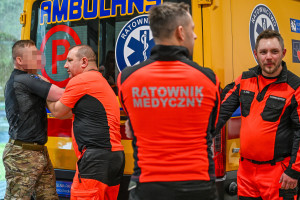Patient in Suicidal Crisis in Ambulance. Guidelines for Paramedics

- Emergency medical services teams are required to conduct an initial suicide risk assessment, secure the patient and ensure continuity of care by transferring the patient to a psychiatric hospital or facility with a psychiatric ward
- Even if the patient denies previous suicidal intentions, the emergency team should treat the situation as potentially life-threatening.
- For children and adolescents, any report of suicidal ideation should be taken seriously. If the patient is under the influence of psychoactive substances, hospitalization is necessary for stabilization and testing.
- If you are experiencing difficulties or want to help a person at risk of suicide, you can use the free helpline numbers: 24/7 800 70 2222 - Support Center for adults in mental crisis, 24/7 800 12 12 12 - Children's Helpline of the Children's Ombudsman, 24/7 116 111 - Helpline for Children and Youth, 24/7 116 123 - Emotional support line for adults
Due to the nature of their work, paramedics and emergency department staff frequently encounter individuals in mental health crisis following a suicide attempt—both children and adults. The community requested detailed guidelines from the national consultant for child and adolescent psychiatry regarding procedures in such cases. A similar letter regarding adult patients was also forwarded by the Ministry of Health to the Office for the Prevention of Suicidal Behavior at the Institute of Psychiatry and Neurology.
Emergency medical services (EMS) are obligated to take protective measures, conduct an initial risk assessment, and ensure continuity of care by transferring the patient to a hospital appropriate for their health condition. In this case, this will be a psychiatric hospital or a facility with a psychiatric ward.
The content of the report, the results of the risk assessment, the course of conversations with witnesses or family, as well as the decision of the head of the medical rescue team and its justification should be recorded in each case in the medical rescue card.
What if the patient, despite intervention, denies previous suicidal intentions?
- If the patient denies suicidal thoughts after the arrival of the Emergency Medical Services, it should be pointed out that the previous reliable information about the suicidal intention still suggests a high risk of suicidal behavior, regardless of the subsequent denial - emphasizes the Ministry of Health.
In such cases, the patient should be transported to an appropriate hospital. The exception is when the following factors occur simultaneously:
- lack of current thoughts/plan/intention/measures;
- presence of strong protective factors and immediate adult/family care;
- possibility of immediate psychiatric/psychological consultation in an outpatient setting;
- no intoxication or severe mental symptoms;
- decision confirmed by teleconsultation with a doctor (preferably a psychiatrist).
If a patient is under the influence of alcohol or other psychoactive substances, intoxication increases the risk of undesirable behavior and prevents or complicates psychiatric assessment. In such cases, the patient must be transported to a psychiatric hospital.
Risk assessment is keyEmergency medical services (EMS) do not perform full psychiatric diagnostics; their role is to provide an initial risk assessment and protect the patient until they are transferred for further care. If there is a reasonable suspicion of an immediate life-threatening situation, transport may be performed without the patient's consent. The emergency medical services manager decides on the hospital to be used.
"EMS do not conduct full psychiatric diagnostics, but rather conduct an initial risk assessment and protect the patient until transfer to further care. In the event of a reasonable suspicion of an immediate life-threatening situation, transport may be possible without the patient's consent," the Ministry of Health states.
Just because a patient or their caregiver has signed a refusal of transport does not mean that paramedics are exempt from their obligation to assess risk or ensure safety.
"In the event of a significant threat, transportation and admission without consent should be provided. A suicidal crisis in a child should be treated as a direct threat to health and life," the ministry added.
The Ministry of Health proposes a specific schemeHere is the procedure for the Emergency Medical Team in such a situation, as proposed by the Ministry of Health:
- Securing the space and your/the patient's safety.
- Initial somatic assessment (ABCDE), emergency treatment.
- Initial suicide risk assessment – short questions, interview with witnesses/family, assessment of access to methods of self-destructive actions.
- Teleconsultation (if available) with a doctor/psychiatrist; in the case of children – preferential pediatric-psychiatric consultation.
- Decision to transport to a hospital with a psychiatric ward: a) YES (default): prior declaration of intent; current thoughts/plans; intoxication; lack of supervision; minor; no possibility of urgent outpatient consultation; symptoms of psychosis/severe depression; access to resources.
b) EXCEPTIONALLY "stays": all criteria met jointly, i.e. no current thoughts/plan/measures, strong protective factors and immediate care of an adult/family, possibility of immediate psychiatric/psychological consultation in an outpatient setting, no intoxication and no severe mental symptoms, decision confirmed by teleconsultation with a doctor (preferably a psychiatrist), + confirmatory teleconsultation + establishment of a specific consultation and supervision plan (time, place, responsible person).
- Documentation: detailed description of the risk, decisions, legal basis, instructions to the patient/guardian, signatures, in the event of actions without consent – description of the searches and means used.
- Transfer of a patient to a hospital with a psychiatric ward – oral/written information, risk assessment results, lists of potentially hazardous substances.
Dr. Aleksandra Lewandowska , a national consultant in child and adolescent psychiatry, provided paramedics with very similar guidelines. She emphasized that any report of suicidal thoughts in a child—regardless of whether the young person confirms them— must be taken seriously as a threat to health and life.
If the child is intoxicated with a psychoactive substance, EMS should transport them to the hospital to stabilize their condition, perform necessary tests, and rule out other causes of impaired consciousness. Once their general condition has been stabilized, an on-site psychiatric consultation should be assessed.
"In hospitals where a psychiatrist is available in the Emergency Department (ED) or on duty at the same facility, a psychiatric consultation should be provided directly in the ED after the patient's clinical condition allows for cooperation with the patient. (...) In hospitals that do not offer on-site psychiatric consultation, once the patient's general condition has stabilized, medical transport to the nearest psychiatric emergency room should be arranged for a psychiatric consultation," emphasizes Aleksandra Lewandowska.
What if a young patient refuses transport to the hospital? In such cases, it's also possible to transport them there without obtaining their consent. Professor Lewandowska points out that leaving a child with suicidal thoughts at the scene of the call is "unacceptable."
***
If you are experiencing difficulties and are thinking about taking your own life or want to help a person at risk of suicide, remember that you can use the free helplines: 24/7 800 70 22 22 - Support Center for adults in mental crisis, 24/7 800 12 12 12 - Children's Helpline of the Children's Ombudsman, 24/7 116 111 - Helpline for Children and Youth, 24/7 116 123 - Emotional support line for adults.
Other telephone numbers and assistance can also be found on the websites: www.zapobiegajmysamobojstwom.pl and www.pokonackryzys.pl .
Copyrighted material - reprint rules are specified in the regulations .
rynekzdrowia













